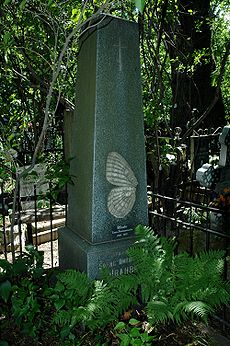
Boris Schwanwitsch
Encyclopedia

Poltava
Poltava is a city in located on the Vorskla River in central Ukraine. It is the administrative center of the Poltava Oblast , as well as the surrounding Poltava Raion of the oblast. Poltava's estimated population is 298,652 ....
– 1957) was a Russian
Russia
Russia or , officially known as both Russia and the Russian Federation , is a country in northern Eurasia. It is a federal semi-presidential republic, comprising 83 federal subjects...
entomologist who specialised in Lepidoptera
Lepidoptera
Lepidoptera is a large order of insects that includes moths and butterflies . It is one of the most widespread and widely recognizable insect orders in the world, encompassing moths and the three superfamilies of butterflies, skipper butterflies, and moth-butterflies...
. He is best known for his studies of the colour pattern of the wings.
Boris Schwanwitz graduated from the St. Petersburg University (1908-1913). After graduation he changed a number of academic positions: assistant lecturer in Entomology at the Stebut Agricultural School (1915), assistant lecturer (1919) and private-docent (1926) at Petrograd (Leningrad) University, professor at the Perm
Perm
Perm is a city and the administrative center of Perm Krai, Russia, located on the banks of the Kama River, in the European part of Russia near the Ural Mountains. From 1940 to 1957 it was named Molotov ....
University (1928-1930). In 1930, he returned to Leningrad (St. Petersburg) to take the position of the head of Entomology department of the Leningrad University (1930-1931 and 1944-1955, 1930 to 1944 the dept. for Entomology was part of the Invertebrate Zoology dept.) Vice-president of the Entomological Society of USSR (1954-1957) and the chair of the Zoology section of the Leningrad Naturalists Society.
In a series of papers he reconstructed the groundplan of the colour-pattern of the wings, first for the Rhopalocera, then for Heteroceran families. He formulated the stereomorphism principle, according to which the cryptic effect of the colour pattern is a result of its 'flattening' (the three-dimensional objects look flat) or 'disjunctive' effect (the two-dimensional objects look like a complex three-dimensional relief). To prove his point he built the plaster three-dimensional models of the lepidopteran wings, the photographs of which looked like an actual colour pattern of stripes and shades (photos were published in a series of papers an in his textbook in entomology). Among his other important contributions are a textbook in entomology with a large morphology section heavily based on Snodgrass
Robert Evans Snodgrass
Robert Evans Snodgrass was an American entomologist and artist who made important contributions to the fields of arthropod morphology, anatomy, evolution, and metamorphosis....
and Weber (1949, still in use in Russian Universities), and a book on practical apiculture (1945). In 1942 he successfully applied the principle of stereomorphism to develop camouflage painting
Military camouflage
Military camouflage is one of many means of deceiving an enemy. In practice, it is the application of colour and materials to battledress and military equipment to conceal them from visual observation. The French slang word camouflage came into common English usage during World War I when the...
for Soviet troops which endured heavy losses by that time.
His gravestone is ornamented with a reproduction of the groundplan of the colour-pattern of lepidopteran wings from his textbook.
Selected publications
- On the groundplan of the wing-pattern in nymphalids and certain other families of rhopalocerous Lepidoptera. Proceedings of the Zoological Society of London, ser. B, 34: 509-528 (1924).
- Wing pattern in Papilionid Lepidoptera Entomologist vol. 76 (1943)
External links
- Kluge Phylogenetics

